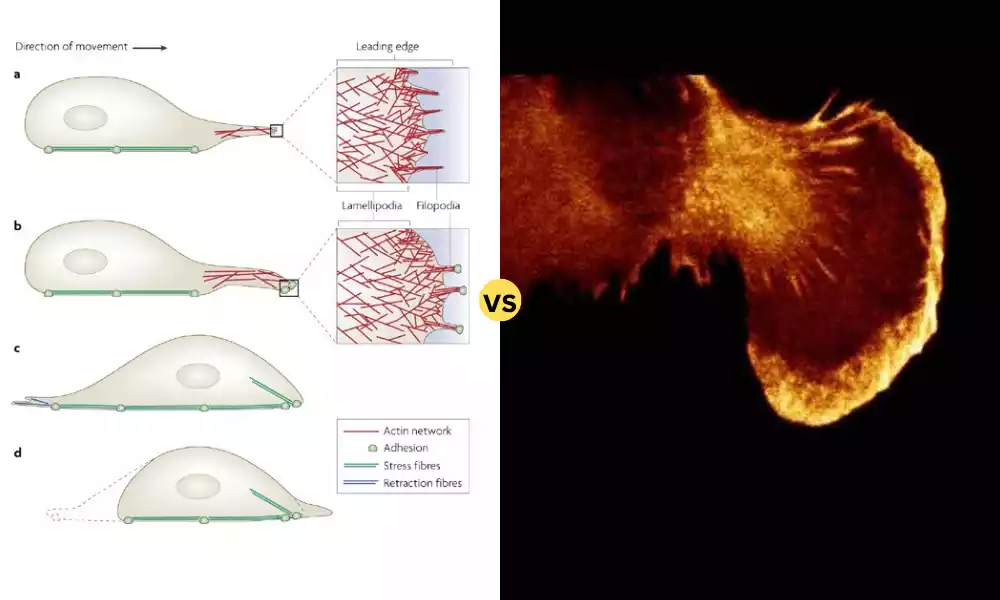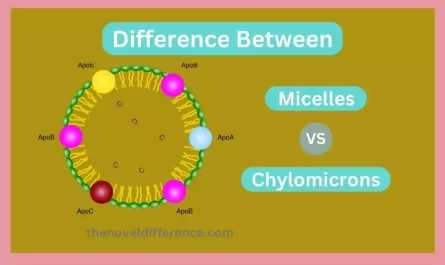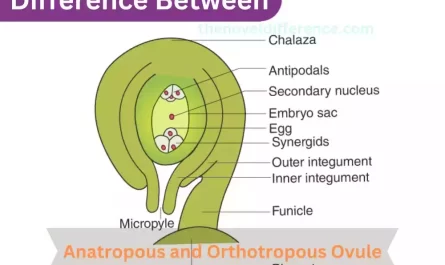Cell biology uncovers fascinating complexities within the microscopic world of living organisms. Lamellipodia and filopodia are two distinct cellular protrusions. which plays a major role in various biological processes. In this article, we will uncover the difference between lamellipodia and filopodia. Let’s highlight their features, functionality, and significance.
What is Lamellipodia?
Lamellipodia are motile, flat, and sheet-like cellular protrusions. which is composed of branched actin filaments. which extend from the tip of the migrating cell. These structures play an important role in cell motility and adhesion by rapidly expanding and retracting. Allows cells to explore their surroundings and respond to extrinsic signals.
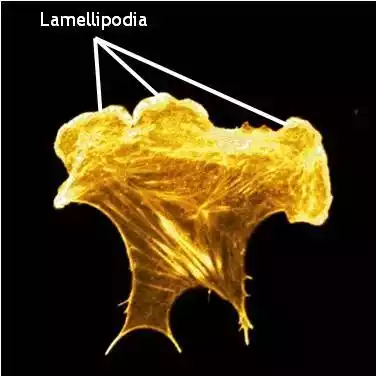
Lamellipodia interact with the extracellular matrix. Guide cell motility through their interactions with adhesion complexes, which facilitate cell migration. These are driven by the orchestrated activity of various actin regulatory proteins such as the Arp2/3 complex.
which is seen in the branches of actin filaments and in lamellipodia. Promotes the formation of characteristic mesh-like structures. mediate their essential contribution to cell migration, tissue development, and immune response. Lamellipodia are fundamental elements of cell biology. which has implications for both physiological processes and disease progression.
Importance of Lamellipodia
Lamellipodia plays an important role in cell movement and migration. Enables a wide range of physiological processes such as embryonic development, tissue repair, immune response, and cancer metastasis. The leading edge of migrating cells rapidly expands and retracts. Lamellipodia allow cells to efficiently explore their environment and respond to extracellular signals.
These dynamic membrane protrusions promote substrate adhesion. Facilitates focal adhesion formation and directs cells along a gradient of chemoattractants. Lamellipodia are helpful in engulfing particles during phagocytosis and facilitating endocytosis processes. Dysregulation of lamellipodia motility can lead to impaired cell migration.
which may contribute to pathological conditions. So, lamellipodia are formed to decipher various physiological and pathological processes. And understanding the molecular mechanisms underlying efficacy is crucial. which holds promise for the development of targeted therapies.
What is Filopodia?
Filopodia are narrow and elongated cellular protrusions. which extend from the cell surface. which consists of bundled actin filaments. These structures play an important role in various cellular processes. Especially in cell communication, sensory perception, and directed cell movement. Filopodia act as specialized sensors.
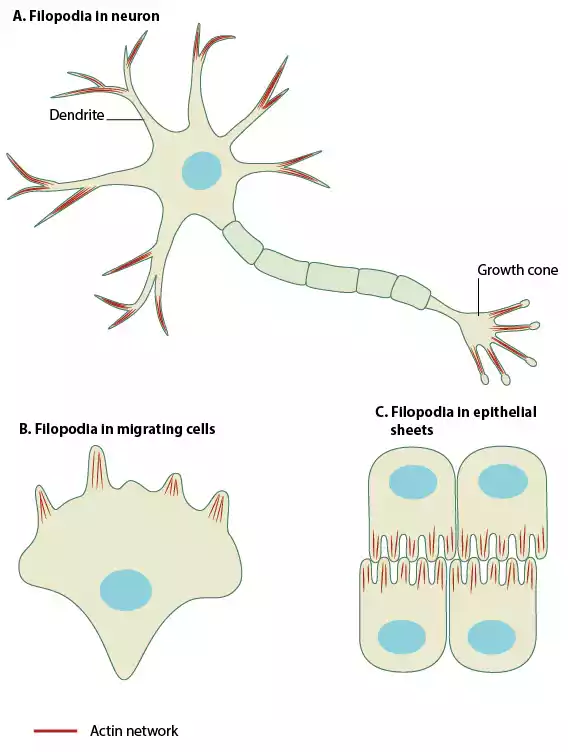
Enables cells to communicate with their environment and respond to external signals. Filopodia are essential for navigating complex environments during axon guidance and synapse formation. Filopodia form contacts between neighboring cells. Contributes to cell-cell communication by facilitating signal exchange.
The formation and stability of filopodia are regulated by actin-binding proteins. which organizes and bundles actin filaments within these narrow protrusions. Understanding the role of filopodia is complex in cellular behavior and its impact on development. which are integral to tissue homeostasis and the unfolding of various pathological conditions.
Importance of Lamellipodia
Lamellipodia plays an important role in cell movement and migration. Enables a wide range of physiological processes such as embryonic development, tissue repair, immune response, and cancer metastasis. The leading edge of migrating cells rapidly expands and retracts. Lamellipodia allow cells to efficiently explore their environment and respond to extracellular signals.
These dynamic membrane protrusions promote substrate adhesion. Facilitates focal adhesion formation and directs cells along a gradient of chemoattractants. Lamellipodia are helpful in engulfing particles during phagocytosis and facilitating endocytosis processes. Dysregulation of lamellipodia motility can lead to impaired cell migration.
which may contribute to pathological conditions. So, lamellipodia are formed to decipher various physiological and pathological processes. And understanding the molecular mechanisms underlying efficacy is crucial. which holds promise for the development of targeted therapies.
Difference Between Lamellipodia and Filopodia
| Aspect | Lamellipodia | Filopodia |
|---|---|---|
| Structure | Flat, sheet-like protrusions | Slender, finger-like protrusions |
| Actin Filaments | Branched actin filament network | Bundled, parallel actin filaments |
| Dynamics | Rapid extension and retraction | Slower, more stable extension |
| Function | Cell migration, adhesion, sensing | Cell communication, sensory roles |
| Role in Movement | Leading edge extension in migration | Exploration, guidance, interaction |
| Cellular Sensing | Less direct sensing, more extension | Direct interaction and sensing |
| Molecular Players | Arp2/3 complex, PI3K, Rac | Actin-bundling proteins, Cdc42 |
| Examples of Cells | Migrating epithelial cells, leukocytes | Neuronal growth cones, fibroblasts |
| Importance | Crucial for cell motility | Essential for sensory perception |
| Pathological Role | Impaired migration in disease | Disruption in neurodevelopment |
Please note that this chart provides a concise overview of the key differences between lamellipodia and filopodia. Further details and nuances can be explored in the more detailed descriptions provided earlier.
Dynamic Properties of Lamellipodia and Filopodia
Dynamic Properties of Lamellipodia:
- Extension and Retraction: Lamellipodia are characterized by rapid and dynamic extension and retraction at the leading edge of migrating cells. They undergo constant changes in shape and size.
- Speed of Extension: Lamellipodia extend quickly, allowing cells to cover a significant distance over short periods. This dynamic movement enables efficient exploration of the extracellular environment.
- Actin Polymerization: Lamellipodia are primarily composed of branched actin filaments. Actin polymerization at the leading edge, driven by the Arp2/3 complex and associated regulatory proteins, facilitates the extension of lamellipodia.
- Substrate Interaction: Lamellipodia plays a critical role in cell adhesion and migration. They engage with the extracellular matrix through focal adhesions, facilitating traction and movement of the cell.
- Sensitivity to External Signals: Lamellipodia respond to external chemoattractants or chemorepellents, guiding cell movement toward or away from specific cues. This responsiveness is essential for directional migration.
Dynamic Properties of Filopodia:
- Stability: Filopodia are more stable and exhibit slower dynamics compared to lamellipodia. They maintain their structure for relatively longer periods.
- Extension Rate: Filopodia extend at a slower rate compared to lamellipodia. This gradual extension allows for precise sensing of the environment and the guidance of delicate processes like neuronal growth.
- Actin Filament Bundling: The core of filopodia is composed of bundled actin filaments, providing structural stability and resistance to mechanical forces.
- Neuronal Guidance: Filopodia are particularly important in guiding the growth cones of developing neurons. They explore the environment, detecting guidance cues, and facilitating the establishment of proper neuronal connections.
- Cell-Cell Interaction: Filopodia are involved in direct interactions between cells. They can form contacts with neighboring cells, facilitating communication and signal exchange.
- Sensory Perception: Filopodia are equipped with receptors that enable them to sense and respond to extracellular signals, which is crucial for processes like chemotaxis and the detection of guidance cues during development.
Both lamellipodia and filopodia contribute to the overall motility and functionality of cells, each with their distinct roles and dynamic characteristics that suit their specific functions in various cellular contexts.
Primary Roles of Lamellipodia and Filopodia
Primary Roles of Lamellipodia:
- Cell Migration: Lamellipodia are essential for cell migration by extending at the leading edge of the cell and providing a platform for cellular movement. They promote the forward movement of cells through their dynamic extension and retraction.
- Substrate Adhesion: Lamellipodia interact with the extracellular matrix, forming focal adhesions that anchor the cell to its environment. This interaction allows cells to exert traction and generate force for movement.
- Directional Sensing: Lamellipodia responds to external cues, such as gradients of chemical signals, guiding the cell’s movement toward sources of attractants or away from repellents.
- Wound Healing: During tissue repair, lamellipodia enable cells to migrate into the wound area, facilitating the closure of gaps and contributing to the restoration of tissue integrity.
- Immune Response: Immune cells, such as leukocytes, utilize lamellipodia during chemotaxis to migrate toward sites of infection or inflammation.
Primary Roles of Filopodia:
- Sensory Perception: Filopodia are crucial for sensory perception and detection of external cues. They explore the surrounding environment, particularly in the case of neuronal growth cones, where they respond to guidance cues during axon pathfinding.
- Cell-Cell Communication: Filopodia plays a role in establishing direct contact between cells, and facilitating the exchange of signals and information. This communication is vital for processes like immune cell interaction and developmental signaling.
- Neuronal Guidance: Filopodia guides the growth cones of developing neurons as they navigate through complex environments to reach their appropriate targets and establish neural connections.
- Tissue Morphogenesis: During development, filopodia contribute to the proper shaping and patterning of tissues by facilitating cell rearrangement and interaction.
- Exploration and Sampling: Filopodia contribute to the exploration of the extracellular environment, allowing cells to sample their surroundings and respond to changes in their microenvironment.
While both lamellipodia and filopodia are involved in cellular protrusions and movement, they have distinct primary roles. Lamellipodia primarily drive cell migration and adhesion, while filopodia are key players in sensory perception, cell communication, and guided growth processes, particularly in the nervous system.
Conclusion
Lamellipodia and Filopodia stand as remarkable structures with distinct roles and functions. While Lamellipodia drives cell movement and interaction, Filopodia excels in cell recognition and connection formation. By understanding the difference between these cellular protrusions, we gain deeper insights into the complex mechanisms that govern cellular behavior and development.

